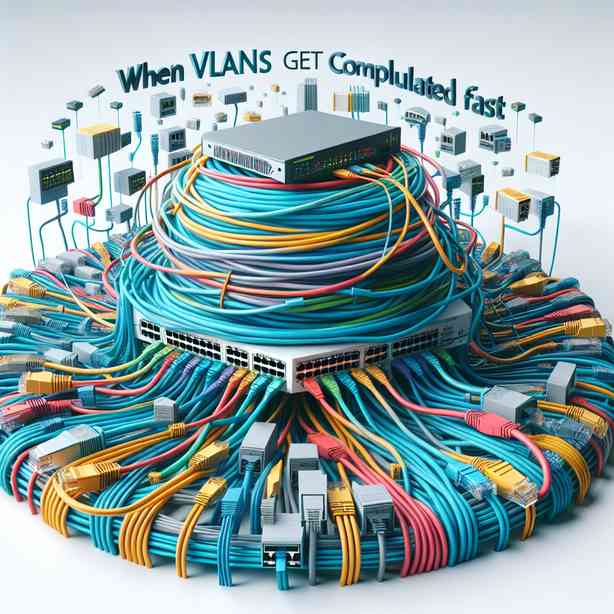
VLANs, or Virtual Local Area Networks, are an essential component of modern networking, allowing organizations to segment their networks for enhanced performance and security. While VLANs initially seem straightforward, the complexities can arise quickly, especially in larger environments or with specific configurations. In this content, we will explore the intricacies of VLANs, how they can become complicated, and best practices for managing this complexity effectively.
At the core of VLAN technology lies the concept of logical partitioning of a network. When multiple devices are connected to the same physical switch, VLAN technology allows you to group these devices into separate logical networks, regardless of their physical location. This segmentation improves network performance by reducing broadcast traffic, enhances security by isolating sensitive data, and simplifies management by allowing administrators to apply policies to groups rather than individual devices.
However, as organizations grow, the need for more VLANs can lead to complexity. Managing multiple VLANs requires careful planning and consideration. One of the most significant challenges arises when determining the appropriate VLAN IDs and ensuring they do not overlap. VLAN IDs are limited to a range from 1 to 4095, which means that in larger networks, especially in multi-site scenarios, maintaining a unique ID across different switches can become cumbersome. This need for unique VLAN identifiers can lead to challenges in consistency and can result in configuration errors if not handled correctly.
Moreover, as networks evolve, the need to interconnect VLANs arises. This can be accomplished through Layer 3 routing, where routers or Layer 3 switches handle traffic between different VLANs. However, this introduces additional layers of complexity. Routing protocols, access control lists (ACLs), and security policies must be meticulously configured to ensure traffic flows correctly and securely between VLANs. A misconfiguration at this stage can lead to security vulnerabilities or disrupted communication between critical applications.
Another layer of complexity is introduced when considering VLAN trunking. Trunk ports are essential for transporting multiple VLANs across a single network link, using protocols like IEEE 802.1Q. However, configuring trunks improperly can disrupt VLAN traffic and potentially expose sensitive information. Protective measures, such as Dynamic Trunking Protocol (DTP) and Port Security, need to be employed to prevent unauthorized access and to maintain network integrity. The proper configuration and management of trunk links can be a daunting task, especially in networks with varying hardware from different manufacturers.
In addition to these considerations, there are also challenges associated with network policies and Quality of Service (QoS). When multiple VLANs share the same physical infrastructure, ensuring consistent policies across all VLANs becomes vital. This includes bandwidth management, prioritizing voice or video traffic, and implementing QoS settings to maintain performance levels. Failure to implement these policies effectively can lead to poor performance and diminished user experience.
Troubleshooting VLAN issues can also become a significant challenge. When problems arise, identifying the source can prove difficult. Whether it’s a misconfigured trunk link, incorrect VLAN assignment, or issues with DHCP relay for VLANs, network administrators need a robust troubleshooting process and tools at their disposal. The complexity of VLAN issues often requires a systematic approach, starting from the physical layer up to the application layer, to isolate and rectify the problem efficiently.
Security is another critical aspect when considering the complexities of VLANs. While VLANs provide some level of isolation, they are not infallible. Attacks such as VLAN hopping can exploit misconfigurations, allowing a malicious actor to access VLANs they are not authorized to use. Enforcing best practices in VLAN security, such as applying strict port security settings and regularly auditing VLAN configurations, is crucial to minimize risks. Additionally, network segmentation through VLANs should be combined with other security measures, such as firewalls and intrusion detection systems, to provide layered security architecture.
Furthermore, as enterprises adopt cloud services and expand their hybrid environments, managing VLANs across on-premises and cloud platforms adds another level of intricacy. Ensuring that VLAN configurations align across different environments, understanding how cloud providers handle VLANs, and managing secure connectivity like VPNs can further complicate the VLAN landscape. It is essential for organizations to take a holistic approach to networking, ensuring that VLAN strategies are adaptable to evolving technology environments and business needs.
To navigate these complexities successfully, organizations should invest in proper training and tools for their network teams. Education on VLAN principles, hands-on lab experience with VLAN configurations, and familiarity with network monitoring tools can significantly enhance a team’s ability to manage VLAN intricacies effectively. Furthermore, leveraging automation tools can help streamline VLAN management processes, ensuring consistency and reducing the chances of human error.
Documentation plays a critical role in managing VLAN complexity. Keeping comprehensive records of VLAN configurations, inter-VLAN routing setups, and security policies is vital for maintaining clarity and ensuring that team members can easily understand and manage the network infrastructure. Regular reviews and updates of documentation help maintain accuracy, especially as the network evolves and new configurations are added.
In conclusion, while VLANs offer significant benefits in terms of segmentation, performance, and security, they can quickly become complicated in larger environments. From managing VLAN IDs and trunking configurations to implementing security measures and troubleshooting issues, it is essential for network administrators to approach VLAN management with a strategic mindset. By investing in training, adopting best practices, and leveraging documentation and automation tools, organizations can navigate the complexities of VLANs effectively and reap their full benefits without compromising network integrity and performance.


